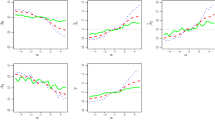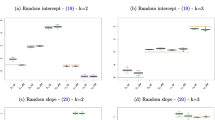Abstract
In this paper we introduce a latent variable model (LVM) for mixed ordinal and continuous responses, where covariate effects on the continuous latent variables are modelled through a flexible semiparametric Gaussian regression model. We extend existing LVMs with the usual linear covariate effects by including nonparametric components for nonlinear effects of continuous covariates and interactions with other covariates as well as spatial effects. Full Bayesian modelling is based on penalized spline and Markov random field priors and is performed by computationally efficient Markov chain Monte Carlo (MCMC) methods. We apply our approach to a German social science survey which motivated our methodological development.
Similar content being viewed by others
References
Aguilar, O., & West, M. (2000). Bayesian dynamic factor models and variance matrix discounting for portfolio allocation. Journal of Business and Economic Statistics 18, 338–357.
Albert, J.H., & Chib, S. (1993). Bayesian analysis of binary and polychotomous response data. Journal of the American Statistical Association, 88, 669–679.
Arminger, G., & Muthén, B.O. (1998). A Bayesian approach to nonlinear latent variable models using the Gibbs sampler and the Metropolis–Hastings algorithm. Psychometrika, 63, 271–300.
BayesX (2005). Software for Bayesian inference by A. Brezger, T. Kneib, & S. Lang. URL: http://www.stat.uni-muenchen.de/~bayesx/bayesx.html
Besag, J.E., York, J., & Mollie, A. (1991). Bayesian image restoration with two applications in spatial statistics (with discussion). Annals of the Institute of Statistical Mathematics, 43, 1–19.
Brezger, A., & Lang, S. (2006). Generalized structured additive regression based on Bayesian P-splines. Computational Statistics and Data Analysis, 50, 967–991.
Cowles, M.K. (1996). Accelerating Monte Carlo Markov chain convergence for cumulative-link generalized linear models. Statistics and Computing, 6, 101–111.
Fahrmeir, L., & Lang, S. (2001). Bayesian semiparametric regression analysis of multicategorical time-space data. Annals of the Institute of Statistical Mathematics, 53, 10–20.
Fahrmeir, L., & Tutz, G. (2001). Multivariate statistical modelling based on generalized linear models. New York: Springer.
Fahrmeir, L., Kneib, T., & Lang, S. (2004). Penalized structured additive regression of space–time data: A Bayesian perspective. Statistica Sinica, 14, 731–761.
Gelman, A., Carlin, J.B., Stern, H.S., & Rubin, D.B. (2004). Bayesian data analysis (2nd ed.). London: Chapman & Hall.
Geweke, J., & Zhou, G. (1996). Measuring the pricing error of the arbitrage pricing theory. Review of Financial Studies, 9, 557–587.
Hastie, T., & Tibshirani, R.J. (1990). Generalized additive models. London: Chapman & Hall.
Hastie, T., & Tibshirani, R.J. (1993). Varying-coefficient models. Journal of the Royal Statistical Society Series B, 55, 757–796.
Hobert, J.P., & Casella, G. (1996). The effect of improper priors on Gibbs sampling in hierarchical linear mixed models. Journal of the American Statistical Association, 91, 1461–1473.
Holmes, C., & Held, L. (2005). Bayesian auxiliary variable models for binary and multinomial regression. Statistical Modelling, 5, 187–199.
Johnson, V.E., & Albert, J.H. (1999). Ordinal data modeling. New York: Springer.
Jöreskog, K.G., & Goldberger, A.S. (1975). Estimation of a model with multiple indicators and multiple causes of a single latent variable. Journal of the American Statistical Association, 70, 631–639.
Kammann, E.E., & Wand, M.P. (2003). Geoadditive models. Journal of the Royal Statistical Society Series C, 52, 1–18.
Lang, S., & Brezger, A. (2004). Bayesian P-splines. Journal of Computational and Graphical Statistics, 13, 183–912.
Lee, S.-Y., & Song, X.-Y. (2004). Bayesian model comparison of nonlinear structural equation models with missing continuous and ordinal categorical data. British Journal of Mathematical and Statistical Psychology, 57, 131–150.
Lee, S.-Y., & Zhu, H.-T. (2000). Statistical analysis of nonlinear structural equation models with continuous and polytomous data. British Journal of Mathematical and Statistical Psychology, 53, 209–232.
Liu, J.S., & Sabatti, C. (2000). Generalised Gibbs sampler and multigrid Monte Carlo for Bayesian computation. Biometrika, 87, 353–369.
Lopes, H.F., & West, M. (2004). Bayesian model assessment in factor analysis. Statistica Sinica, 14, 41–47.
Lu, Y., & Wang, X. (2006). A hierarchical Bayesian framework for item response theory models with applications in ideal point estimation. Technical Report, Harvard University, Institute for Quantitative Social Science.
MCMCPack (2005). R-package for Markov chain Monte Carlo by A.D. Martin & K.M. Quinn. URL: http://mcmcpack.wustl.edu/
Moustaki, I. (2003). A general class of latent variable models for ordinal manifest variables with covariate effects on the manifest and latent variables. British Journal of Mathematical and Statistical Psychology, 56, 337–357.
Moustaki, I., & Steele, F. (2005). Latent variable models for mixed categorical and survival responses, with an application to fertility preferences and family planning in Bangladesh. Statistical Modeling, 5, 327–342.
Moustaki, I., Jöreskog, K.G., & Mavridis, D. (2004). Factor models for ordinal variables with covariate effects on the manifest and latent variables: A comparison of LISREL and IRT approaches. Structural Equation Modeling, 11, 487–513.
Muthén, B.O. (1989). Latent variable modeling in heterogeneous populations. Psychometrika, 54, 557–585.
O’Brien, S.M., & Dunson, D.B. (2004). Bayesian multivariate logistic regression. Biometrics, 60, 739–746.
Patz, R.J., & Junker, B.W. (1999a). A straightforward approach to Markov chain Monte Carlo methods for item response models. Journal of Educational and Behavioral Statistics, 24, 146–178.
Patz, R.J., & Junker, B.W. (1999b). Applications and extensions of MCMC in IRT: Multiple item types, missing data, and rated responses. Journal of Educational and Behavioral Statistics, 24, 342–366.
Quinn, K.M. (2004). Bayesian factor analysis for mixed ordinal and continuous responses. Political Analysis, 12, 338–353.
Raach, A. (2005). A Bayesian semiparametric latent variable model for binary, ordinal and continuous response. Dissertation, available from edoc.ub.uni-muenchen.de
Rue, H. (2001). Fast sampling of Gaussian Markov random fields. Journal of the Royal Statistical Society Series B, 63, 325–338.
Rue, H., & Held, L. (2005). Gaussian Markov random fields: Theory and applications. London: Chapman & Hall.
Rupp, A.A., Dey, D.K., & Zumbo, B.D. (2004). To Bayes or not to Bayes, from whether to when: Applications of Bayesian methodology to modeling. Structural Equation Modeling, 11, 424–451.
Sahu, S.K. (2002). Bayesian estimation and model choice in Item Response Model. Journal of Statistical Computation and Simulation, 72, 217–232.
Sammel, M.D., Ryan, L.M., & Legler, J.M. (1997). Latent variable models for mixed discrete and continuous outcomes. Journal of the Royal Statistical Society Series B, 59, 667–678.
Skrondal, A., & Rabe-Hesketh, S. (2004). Generalized latent variable modeling. London: Chapman and Hall.
Song, X.-Y., & Lee, S.-Y. (2005). Statistical analysis of a two-level nonlinear structural equation model with fixed covariates. Journal of Educational and Behavioral Statistics, 30, 1–16.
Sun, D., Tsutakawa, R.K., & He, Z. (2001). Propriety of posteriors with improper priors in hierarchical linear mixed models. Statistica Sinica, 11, 77–85.
Zhu, J., Eickhoff, J.C., & Yan, P. (2005). Generalized linear latent variable models for repeated measures of spatially correlated multivariate data. Biometrics, 61, 674–683.
Author information
Authors and Affiliations
Corresponding author
Additional information
We thank the editor and the referees for their constructive and helpful comments, leading to substantial improvements of a first version, and Sven Steinert for computational assistance. Partial financial support from the SFB 386 “Statistical Analysis of Discrete Structures” is also acknowledged.
Rights and permissions
About this article
Cite this article
Fahrmeir, L., Raach, A. A Bayesian Semiparametric Latent Variable Model for Mixed Responses. Psychometrika 72, 327–346 (2007). https://doi.org/10.1007/s11336-007-9010-7
Received:
Revised:
Published:
Issue Date:
DOI: https://doi.org/10.1007/s11336-007-9010-7




